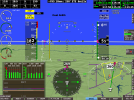The transition was pretty easy and quick. The condensation of scan when flying IFR approaches is a terrific safety feature. Everything is right in front of you. My hardest scan habit to break was referring to the analog altimeter, although it's not a bad thing to verify that the G5 and the analog altimeter are saying the same thing plus or minus. The analog airspeed scan was the easiest to ditch, but the analog turn coordinator is still useful for making standard rate turns. A huge plus is no parallax in the AI, and it's incredibly precise for flying "by the numbers."
Something to be aware of is the G5 AI is set to zero degrees at a fixed attitude (usually with the aircraft level on the ground) and is not adjustable in flight for a certificated install. So you may have to learn new "numbers". For example, for my plane, level flight at 90 kt and 2200 rpm is 2 degrees nose up, a 90 kt descent at 500 fpm at 1900 rpm is one degree nose down, Vy climb at full throttle is 8 degrees nose up, etc. These are reproducible from flight to flight.
The biggest gotcha is ingraining the correct buttonology to set up GPSS roll steering with the autopilot. Miss a button or two and the AP goes off in an unexpected direction. Best to work that out in VFR conditions.
i'd never prefer to give up my dual G5s for analog gauges. They are a game changer. And I got to rip out the vacuum system to boot.

